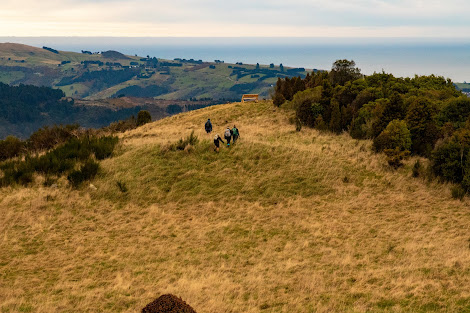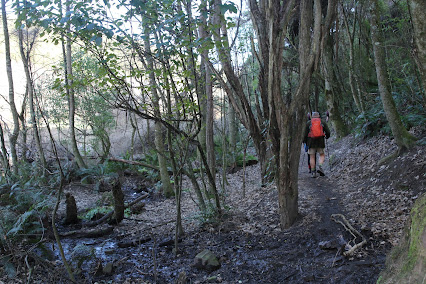Today's trip was run as an acknowledgement of the importance of the Family Tramping Group, which was an offshoot of the OTMC from the late 1960's to the 1990's and provided trips for club members that had young families so they could participate in tramping trips. One trip that ran every year on the third Sunday in August was a picnic lunch at the Ben Rudd's which is why ll of us headed up the Firebreak Track from the Bullring to recreate this trip. The Firebreak Track starts directly behind the locked gate and is a steep but steady climb gaining 100m fairly quickly.
After about a kilometre on the Firebreak track, we branched off, taking a side track as an alternative route to the Ben Rudd Shelter. This track has recently been cut back by the Green Hut Track Group and we were grateful as it winds it's way through the flax and tussock, over rocks and tree roots, through patches of manuka and past rock tors on it's way to Ben Rudds. Last time I had been up this track, it had been so overgrown that we almost lost our way a couple of times, as we pushed through the tussock, unable to see more than a few centimetres in any direction. Today the track is well cut back, dry underfoot and easy to follow making for a nice alternative to the standard route to Ben Rudds.
After the fun of the side track we emerged at the Ben Rudd shelter in time for an early lunch. We each found a place to sit, either in the shelter or outside on the grass and reminisced about previous family group trips (for those who had been on them) and previous trips to Ben Rudds (for the rest of us). Home baking was shared around and we spent much longer on lunch than we had on recent trips. After lunch we walked up the usual track to the Firebreak Track and along to the Cross Track. We had been along this part of the track just two weeks ago and there was a marked difference with the track much drier now. From the Cross track it is a short walk up the Pineapple Track to the top of Flagstaff where we were rewarded with outstanding views of the city. We stopped for a few moments at the plane table on Flagstaff to ponder the changes that have occurred since the plane table was installed for the OTMC's 50th celebrations and here we are today, celebrating 100 years. A very fitting spot and I often think, when here, that this is where you get the BEST views of the city and surrounding area. As we know - what goes up must come down and which is a kilometre or so downhill to the cars. It is a steep 160m descent on the wide, gravel track which is popular with families, dog walkers and runners - and the bonus is that it is reasonably dry underfoot all year round. It was a fast walk down the hill and we arrived back at the cars having walked around 5km in less than 2.5 hours (including a long lunch) - exactly the sort of trip that was popular in the Family Tramping Group.
























































